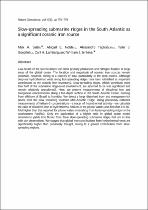 ResearchSpace
ResearchSpace
Slow-spreading submarine ridges in the South Atlantic as a significant oceanic iron source
JavaScript is disabled for your browser. Some features of this site may not work without it.
- ResearchSpace
- →
- Research Publications/Outputs
- →
- Journal Articles
- →
- View Item
| dc.contributor.author |
Saito, MA

|
|
| dc.contributor.author |
Noble, AE

|
|
| dc.contributor.author |
Tagliabue, A

|
|
| dc.contributor.author |
Goepfert, TJ

|
|
| dc.contributor.author |
Lamborg, CH

|
|
| dc.contributor.author |
Jenkins, WJ

|
|
| dc.date.accessioned | 2014-06-17T09:51:57Z | |
| dc.date.available | 2014-06-17T09:51:57Z | |
| dc.date.issued | 2013-09 | |
| dc.identifier.citation | Saito, M.A, Noble, A.E, Tagliabue, A, Goepfert, T.J, Lamborg, C.H and Jenkins, W.J. 2013. Slow-spreading submarine ridges in the South Atlantic as a significant oceanic iron source. Nature Geoscience, vol. 6(9), pp 775–779 | en_US |
| dc.identifier.issn | 1752-0894 | |
| dc.identifier.uri | http://www.nature.com/ngeo/journal/v6/n9/full/ngeo1893.html | |
| dc.identifier.uri | http://hdl.handle.net/10204/7442 | |
| dc.description | Copyright: 2013 Nature Publishing Group. This is an ABSTRACT ONLY. The definitive version is published in Nature Geoscience, vol. 6(9), pp 775–779 | en_US |
| dc.description.abstract | Low levels of the micronutrient iron limit primary production and nitrogen fixation in large areas of the global ocean. The location and magnitude of oceanic iron sources remain uncertain, however, owing to a scarcity of data, particularly in the deep ocean. Although deep-sea hydrothermal vents along fast-spreading ridges have been identified as important contributors to the oceanic iron inventory, slow-spreading ridges, which contribute more than half of the submarine ridge-crest environment, are assumed to be less significant and remain relatively unexplored(2). Here, we present measurements of dissolved iron and manganese concentrations along a full-depth section in the South Atlantic Ocean, running from offshore of Brazil to Namibia. We detect a large dissolved iron-and manganese-rich plume over the slow-spreading southern Mid-Atlantic Ridge. Using previously collected measurements of helium-3 concentrations-a tracer of hydrothermal activity-we calculate the ratio of dissolved iron to hydrothermal helium in the plume waters and find that it is 80-fold higher than that reported for plume waters emanating from faster-spreading ridges in the southeastern Pacific. Only the application of a higher ratio in global ocean model simulations yields iron fluxes from these slow-spreading submarine ridges that are in line with our observations. We suggest that global iron contributions from hydrothermal vents are significantly higher than previously thought, owing to a greater contribution from slow-spreading regions. | en_US |
| dc.language.iso | en | en_US |
| dc.publisher | Nature Publishing Group | en_US |
| dc.relation.ispartofseries | Workflow;12858 | |
| dc.subject | East Pacific rise | en_US |
| dc.subject | Hydrothermal plume | en_US |
| dc.subject | Oxidation-Kinetics | en_US |
| dc.subject | Dissolved Iron | en_US |
| dc.subject | Seawater | en_US |
| dc.subject | Micronutrient iron | en_US |
| dc.subject | Nitrogen fixation | en_US |
| dc.subject | South Atlantic Ocean | en_US |
| dc.title | Slow-spreading submarine ridges in the South Atlantic as a significant oceanic iron source | en_US |
| dc.type | Article | en_US |
| dc.identifier.apacitation | Saito, M., Noble, A., Tagliabue, A., Goepfert, T., Lamborg, C., & Jenkins, W. (2013). Slow-spreading submarine ridges in the South Atlantic as a significant oceanic iron source. http://hdl.handle.net/10204/7442 | en_ZA |
| dc.identifier.chicagocitation | Saito, MA, AE Noble, A Tagliabue, TJ Goepfert, CH Lamborg, and WJ Jenkins "Slow-spreading submarine ridges in the South Atlantic as a significant oceanic iron source." (2013) http://hdl.handle.net/10204/7442 | en_ZA |
| dc.identifier.vancouvercitation | Saito M, Noble A, Tagliabue A, Goepfert T, Lamborg C, Jenkins W. Slow-spreading submarine ridges in the South Atlantic as a significant oceanic iron source. 2013; http://hdl.handle.net/10204/7442. | en_ZA |
| dc.identifier.ris | TY - Article AU - Saito, MA AU - Noble, AE AU - Tagliabue, A AU - Goepfert, TJ AU - Lamborg, CH AU - Jenkins, WJ AB - Low levels of the micronutrient iron limit primary production and nitrogen fixation in large areas of the global ocean. The location and magnitude of oceanic iron sources remain uncertain, however, owing to a scarcity of data, particularly in the deep ocean. Although deep-sea hydrothermal vents along fast-spreading ridges have been identified as important contributors to the oceanic iron inventory, slow-spreading ridges, which contribute more than half of the submarine ridge-crest environment, are assumed to be less significant and remain relatively unexplored(2). Here, we present measurements of dissolved iron and manganese concentrations along a full-depth section in the South Atlantic Ocean, running from offshore of Brazil to Namibia. We detect a large dissolved iron-and manganese-rich plume over the slow-spreading southern Mid-Atlantic Ridge. Using previously collected measurements of helium-3 concentrations-a tracer of hydrothermal activity-we calculate the ratio of dissolved iron to hydrothermal helium in the plume waters and find that it is 80-fold higher than that reported for plume waters emanating from faster-spreading ridges in the southeastern Pacific. Only the application of a higher ratio in global ocean model simulations yields iron fluxes from these slow-spreading submarine ridges that are in line with our observations. We suggest that global iron contributions from hydrothermal vents are significantly higher than previously thought, owing to a greater contribution from slow-spreading regions. DA - 2013-09 DB - ResearchSpace DP - CSIR KW - East Pacific rise KW - Hydrothermal plume KW - Oxidation-Kinetics KW - Dissolved Iron KW - Seawater KW - Micronutrient iron KW - Nitrogen fixation KW - South Atlantic Ocean LK - https://researchspace.csir.co.za PY - 2013 SM - 1752-0894 T1 - Slow-spreading submarine ridges in the South Atlantic as a significant oceanic iron source TI - Slow-spreading submarine ridges in the South Atlantic as a significant oceanic iron source UR - http://hdl.handle.net/10204/7442 ER - | en_ZA |





